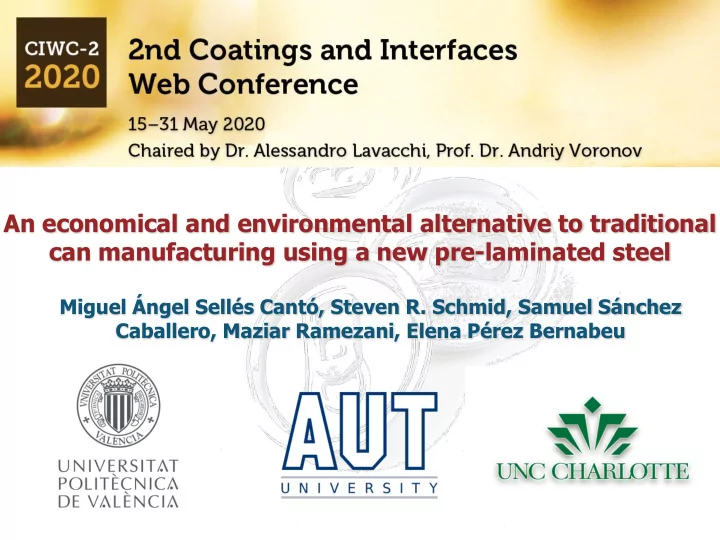

An economical and environmental alternative to traditional can manufacturing using a new pre-laminated steel Miguel Ángel Sellés Cantó, Steven R. Schmid, Samuel Sánchez Caballero, Maziar Ramezani, Elena Pérez Bernabeu
Outline Introduction Theoretical modelization Experimental Results Conclusions 2
Introduc Introduction tion Context I n t r o d u c t i o n Source: MarketsandMarkets.com 3
Introduction Introduc tion Steps in can manufacturing I n t r Doming Sheet metal is lubricated Drawing, Redrawing, Metal coil Cutting and small discs are cutted Ironing o d u c Wash and dry External coating Coating drying on a furnace External decoration t Lubricant removal Base for ink i o n Necking Sprayed internal coating Internal coating drying Decoration drying 4
Introduction Introduc tion Alternative of a precoated sheet I n Advantages: t Reduction of manufacturing steps. r Reduction of time in the manufacturing cycle. o Reduction of costs. d u c t Disadvantages: i More expensive material. o Possible damage to polymer layers. n 5
Introduc Introduction tion Reduction of steps in can manufacturing I X X X n t r o d Lubrication External coating Washing and drying u X X X c t i o n Coating drying Internal coating Coating drying 6
Introduction Introduc tion Objective of this research I Study the processability in the use of a steel sheet n coated with two polymer layers. t Carry out a theoretical model of the optimum process r conditions. o Validate this model with experiments on an ironing d simulator. u If viability is demonstrated, it would be possible: c -manufacture metal containers without VOCs t emissions ⇒ environmental improvement. i -get a greater internal insulation between o beverage and metal. n -improve the mechanical properties of can. 7
Introduction Introduc tion Material characteristics I Material provided by ArcelorMittal. n t Top layer r Tie layer o d Steel u c t i Tie layer: Characteristics of maximum adhesion to metal. o Top layer: Characteristics of high strength and good mechanical properties. Good properties for friction. n 8
Theoreti Theoretical Mo cal Model del T Ironing h e o r It’s the most crucial step in a polymer-coated can manufacturing. e t Variables: i Mat Materi erial al c Tem Temper peratu ature re a Die Die an angle gle l Red Reduct uction ion in thi thickn ckness ess M Pun Punch ch vel veloc ocity ity o d e l 9
Theoreti Theoretical mo cal model del T Upper bound: Successful ironing h e o r e t i c a l M o d e l 10
Theoreti Theoretical Mo cal Model del T Upper bound: Shaving h e o r e t i c a l M o d e l 11
Theoreti Theoretical Mo cal Model del T Artificial Neural Network of Ironing h e o r e t i c a l M o d e l 12
Experimental Experime ntal Ironing Simulator E x p e r i m e n t a l 13
Experime Experimental ntal Design of experiments E x Process variables Levels p e Die angle º 2 4 6 8 10 r Punch velocity m/s 0,5 0,75 1 i Reduction % 5 10 15 20 m e Die temperature ºC 25 100 n t D-optimal design a l Design Expert TM 14
Results Results Theoretical results R e Φ ≈ 4.8º s u l t s 15
Results Results Surface Quality Factor (SQF) It’s a qualitative factor. Surfaces are compared to the following ones: R e s u NO IRONING SQF=0 SQF=2 l t s SQF=8 SQF=4 SQF=10 16
Results Results Surface Quality Factor (SQF) R e s u l t s 17
Results Results Roughness R e s u l t s 18
Conclusi Conclusions ons Conclusions C Die angle is the most important variable. Good ironings have been achieved with angles of 6º or lower. o n Punch speed and temperature have less significancy over the ironing quality. c l Experimental results are very close to those obtained with u the theoretical upper bound models. s The new 2 layer-polymer coated material survived to the i most critical step in can manufaturing (ironing), under certain conditions. o n Several steps in traditional can manufacturing can be eliminated: reduces cost and benefits environment. s 19
Thank you for your attention maselles@dimm.upv.es steve.schmid@uncc.edu sasanca@dimm.upv.es maziar.ramezani@aut.ac.nz elenapb@eio.upv.es
Recommend
More recommend